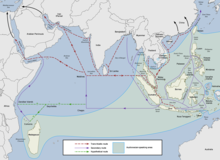Age of Sail

The Age of Sail is a period that lasted at the latest from the mid-16th (or mid-15th)[1] to the mid-19th centuries, in which the dominance of sailing ships in global trade and warfare culminated, particularly marked by the introduction of naval artillery, and ultimately reached its highest extent at the advent of the analogue Age of Steam. Enabled by the advances of the related Age of Navigation, it is identified as a distinctive element of the early modern period[2] and the Age of Discovery. Especially in context of the latter, it refers to a more particular Eurocentric Age of Sail, while generally the Age of Sail is the culminating period of a long intercontinental history of sailing.[1]
Periodization
This section needs additional citations for verification. (July 2021) |
Like most

Sailing ships are an ancient technology, making far-reaching trade like the ancient
For warships, the age of sail runs roughly from the
Golden Age of Sail
The period between the mid-19th century to the early 20th century, when sailing vessels reached their peak of size and complexity (e.g. clippers and windjammers), is sometimes referred to as the "Golden Age of Sail".[6]
Decline
The second sea-going steamboat was Richard Wright's first steamboat Experiment, an ex-French lugger; she steamed from Leeds to Yarmouth in July 1813.[7][8] The first iron steamship to go to sea was the 116-ton Aaron Manby, built in 1821 by Aaron Manby at the Horseley Ironworks, and became the first iron-built vessel to put to sea when she crossed the English Channel in 1822, arriving in Paris on 22 June.[9] She carried passengers and freight to Paris in 1822 at an average speed of 8 knots (9 mph, 14 km/h).
The first purpose-built steam battleship was the 90-gun
The
By 1873, the Age of Sail for warships had ended,[citation needed] with HMS Devastation commissioned in 1871. Devastation was the first class of ocean-going battleships that did not carry sails.

Sailing ships continued to be an economical way to transport bulk cargo on long voyages into the 1920s and 1930s, though steamships soon pushed them out of those trades as well. Sailing ships do not require fuel or complex engines to be powered; thus they tended to be more independent from sophisticated dedicated support bases on land. Crucially though, steam-powered ships held a speed advantage and were rarely hindered by adverse winds, freeing steam-powered vessels from the necessity of following
Sailing vessels were pushed into narrower and narrower economic niches and gradually disappeared from commercial trade. Today, sailing vessels are only economically viable for small-scale coastal fishing, along with recreational uses such as yachting and passenger sail excursion ships.
In recent decades, the commercial shipping industry has been reviving interest in wind assisted ships as a way to conserve fuel in the interest of sustainability.[citation needed]
Legacy
A New Age of Sail has been predicted by some experts to occur by 2030, driven by a revolution in energy technology and a desire to reduce
See also
- Age of Discovery
- Columbian Exchange
- Indian Ocean trade
- Maritime Silk Road
- Maritime timeline
- Naval history
- Sailing ship tactics
- Sea lane
Notes
- ^ The distance from London to Fuzhou via the Cape of Good Hope is 13,358 nmi (24,739 km), compared to 10,120 nmi (18,740 km) via the Suez canal.[13] Sailing vessels going around the south of Africa would typically sail over 14,000 nmi (26,000 km) as their routes were adjusted to find favourable winds.[14]: 31
References
- ^ S2CID 161330041.
- ^ "The Age of Sail". HMS Trincomalee. Archived from the original on 2016-03-16. Retrieved 12 April 2016.
{{cite web}}: CS1 maint: unfit URL (link) - ISBN 9783319338224.
- JSTOR 41493537. Retrieved 2021-08-18.
- ^ "The 74—the Perfect Age-of-Sail Ship". U.S. Naval Institute. 2019-02-01. Retrieved 2022-10-05.
- ^ "Sailing Ship Rigs" Archived 2010-12-28 at the Wayback Machine. Maritime Museum of the Atlantic
- ^ Malster, R (1971), Wherries & Waterways, Lavenham, p. 61
{{citation}}: CS1 maint: location missing publisher (link). - ^ Stephen, L. (1894). DNB. Smith, Elder, & Company. p. 399. Retrieved 2017-12-28.
- ^ "The First Steamboat Services in Europe". The Artist as Witness: Images of Technology. 2002. Archived from the original on 5 November 2004. Retrieved 21 July 2021.
- ^ Lambert, A. "The Screw Propellor Warship", in Gardiner Steam, Steel and Shellfire pp. 30–44.
- ISBN 0-415-21478-5, pp. 73–74.
- ISBN 0-85177-563-2.
- ^ maritime data systems. "Sea Routes". m.classic.searoutes.com. Retrieved 18 August 2021.
- ISBN 0-85177-256-0.
- ^ "New age of sail looks to slash massive maritime carbon emissions". Mongabay Environmental News. 2021-03-15. Retrieved 2021-06-07.
- ISBN 978-1-5261-6309-7.
